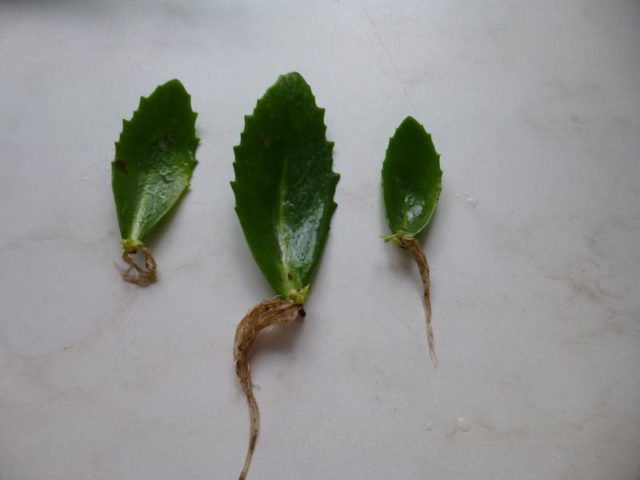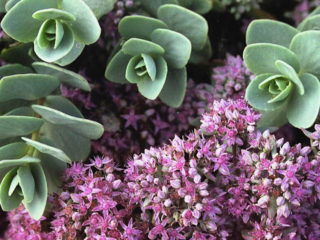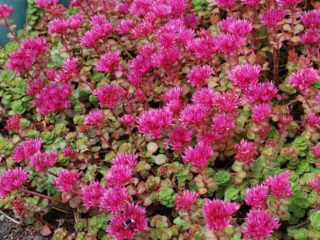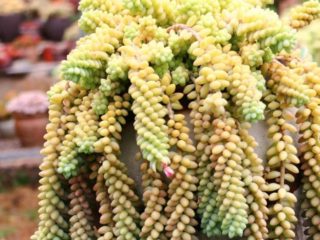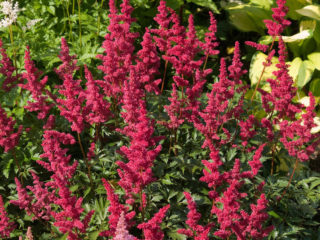Content
Sedum or sedum is a perennial succulent plant of the Crassulaceae family. In the wild it is found in meadows and slopes, preferring to settle on dry soils. The culture is represented not only by species, but also by hybrid varieties, so the propagation of sedums depends on this factor.
Peculiarities of sedum reproduction
The genus includes more than 500 species; sedum grows in the form of a subshrub, less commonly a shrub. Hybrid dwarf varieties with creeping stems are used in design as ground cover plants. Flowers of varieties of different colors are collected in thyroid or racemose inflorescences. The leaves are thick, fleshy, and are also used for propagation of sedum.
Sedum propagation is carried out by all known methods:
- rooting of shoots;
- cuttings;
- dividing the bush;
- seeds;
- leaves.
The timing of placing sedum on the site depends on the chosen planting method.
How to propagate sedum
Sedum that has entered reproductive age is suitable for any method of reproduction. If the plant has bloomed, it is considered an adult; small boxes filled with seeds are formed on the inflorescences. This specimen can be divided or layered next year. Sedum is one of the few species for which propagation by leaves is possible. The material is taken at any growing season:
- choose a large leaf plate without damage;
- place the bottom part in a container of water and leave until root threads appear;
- then placed in a container filled with fertile substrate;
- After planting, the sedum is not watered for 3-4 days.
If rooting is successful, a sprout will appear in a month. When it rises above the ground by about 3-5 cm, you can place it in a permanent place.
How to propagate sedum by dividing the rhizome
For this propagation method, sedums that are at least 3 years old are used. If the variety has a two-year biological cycle, then division is carried out a year after planting. The time for work is determined in the spring (before flowering) or autumn (after the seeds ripen).
Subsequence:
- The bush is watered abundantly so that the root is not damaged when removing the sedum from the soil.
- The sedum is dug up and the remaining soil is removed.
- Cut into pieces, the number of plots depends on how much the bush has grown. The planting material must have at least three replacement buds.
- Leave in the shade for 2 days to allow the sections to dry.
Then they are determined to the site.
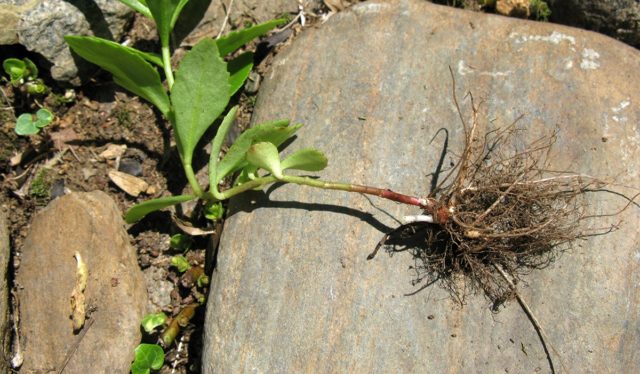
If the soil is sandy and dry, you can treat the cuttings with charcoal and plant immediately
How to propagate sedum from cuttings
Propagation by cuttings of sedum can be done at the beginning of the season or in the fall. This method is the most common. The timing of material procurement depends on the type of sedum. Reproduction of ground cover dwarf forms by cuttings is carried out in the spring:
- From the tops of the shoots, cut into pieces 8 cm long.
- Remove all the lower leaves, leaving 2-3 on the top.
- Place in fertile soil consisting of sand and compost mixed in equal quantities.
- It is better to use peat cups, but you can place the rooting material directly into the ground, and determine a place in the shade with minimal humidity.
- If the cuttings are in a container, they are left on the site in a shaded place.
After approximately 3 weeks, the sedum will take root and can be planted in a flower bed.
Propagation by cuttings of erect bush-shaped sedum is carried out in the fall at home:
- Before the onset of frost, material 15 cm long is cut from the shoots.
- In the room they lay out on a plane.
- After some time, the leaves will begin to fall off, and shoots will appear from the buds located in the leaf axils along with root threads.
- When they grow to 6 cm, they are carefully broken off and placed in a container with substrate.
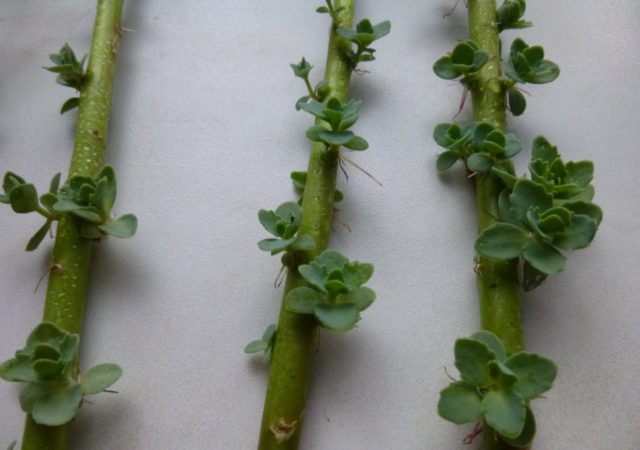
In the spring at the end of May they are planted on the site
The container with the material is kept at a temperature of +200 C, provide sedum with fourteen-hour illumination. With a lack of light, the sprouts stretch.
How to propagate sedum by seeds
Planting material can be purchased at a retail chain or collected from the plant yourself. The seed pods are small, but there are a large number of them, so there will be no problems with harvesting. The inflorescences are cut off at the first signs of opening of the shell.Lay out on a light surface, the boxes will open on their own.
Sedum varieties bloom in spring or fall. The seeds are collected after they ripen. If these are early flowering varieties, then after harvesting you can immediately sow them in the ground or leave them until spring. For autumn-flowering representatives, propagation by seedlings is used.
Sowing seeds in open ground:
- The bed is loosened and all vegetation is removed.
- Prepare a mixture of sand and compost and pour it onto the surface.
- Make longitudinal furrows 0.5 cm deep.
- Sow seeds without keeping a distance.
- Lightly cover with substrate.
Water the sedum sowing site at intervals of 5 days until shoots appear.
For seedlings, the material is sown in a container with the same nutrient mixture. The sequence of work does not differ from activities in an open area. The sedum is not watered, only the soil is sprayed until shoots appear.
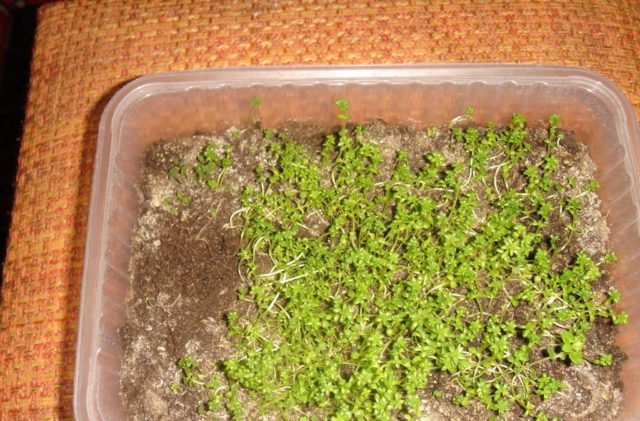
The strongest seedlings are selected from the total mass and planted in separate containers
After planting, the sedum is left indoors until spring; at the beginning of the season it is planted in a flower bed. By autumn the plant will bloom.
Rules for caring for sedums after propagation
The plant is planted in an open, well-drained area. Excess moisture is detrimental to sedum. The young plant is watered only in case of drought, no more than once a week with a small amount of water. For adult sedum, seasonal precipitation is sufficient, even if its amount is below normal.
They monitor the condition of the root circle; the soil must be aerated so that the sedum grows the root system, so the soil is constantly loosened. Mandatory agricultural practices include the removal of weeds, since seedlings will not be able to fully develop if they compete for food.
Feed with nitrogen after autumn propagation. It is applied in early spring. At the time of budding, complex mineral fertilizers are used, and organic matter is added in the fall. If the spring planting of sedum is not fertilized, it receives enough nutrition from the substrate.
Some of the crop varieties are frost-resistant; they can winter without insulation. There are hybrid varieties that cover in the fall. The above-ground part is not cut off. In the spring, dry and problem areas are removed; overwintered leaves are necessary for sedum for photosynthesis. After the formation of a new crown, they will fall off on their own.
Useful tips
Sedum has simple agricultural technology. The plants are characterized by high vitality, the bushes grow quickly, even if the roots are damaged by frost. Reproduction is a simple undertaking, but always effective.
A few tips will help you navigate the process correctly:
- The seeds of sedum are small, it is difficult to disinfect them with regular soaking, so the material is laid out on film and sprayed with a manganese solution.
- Before sowing the plot in the spring, the planting material is hardened in the refrigerator.
- The layering method is a fairly successful method, especially for low-growing varieties. The shoot is simply bent to the ground so that its lower part touches the surface and secured. There is no need to fill it with soil; the plant will take root in the area of the leaf axils.
- If they are grown by cuttings cut in the fall, it is better to cut off the shoots with a blade along with a fragment of the stem; if broken, some of the root threads can be damaged.
- You cannot water a young plant often, as an excess of moisture will lead to rotting.
Conclusion
Sedum propagation is carried out by various methods, depending on the type of crop.For upright varieties, dividing the bush, cuttings, and the seed method are used. The generative method is not suitable for hybrids. Low-growing specimens can be propagated by layering or cuttings. Sedum is frost-resistant, so work is carried out both in spring and autumn.
